Brigidine College St Ives 2022 HSC Showcase

Welcome to the 2022 HSC Major Works Showcase.
We are delighted to acknowledge the effort, expertise, creativity and hours that have gone into each one of these HSC Major Works. Areas represented within this exhibition catalogue include Visual Arts, Textiles and Design, Extension English 2, Science Extension, Society and Culture and History Extension.
HSC teachers at Brigidine are dedicated to fostering a commitment to excellence and originality in their students and the showcase is testament to this. I am proud that both staff and students persevered in their learning journey at a time when the constraints of Covid-19 are still with us. The final works of our HSC students are outstanding.
The staff who have worked alongside our students to produce these major works, have been on the demanding journey that a major HSC project brings. This includes many additional hours outside of class time. I would like to acknowledge the guidance and support given to the girls by their teachers, they have mentored and guided, and stayed the journey with you.
As graduates, I hope our Year 12 students will continue to grow to be courageous young women who act with strength and gentleness. Our hope is that throughout your lives you will continue to explore creative and academic pursuits that challenge and highlight your skill, expertise and knowledge.
As Principal, alongside their teachers, we are incredibly proud of their efforts, and we are pleased to be able to showcase their achievements here. Please enjoy this record of achievement!
Ms Laetitia Richmond Principal

Graphic Design: Lisa Foulstone Proofing: Mandy Loomes Cover Artwork: Dualistic Plane, Painting By Sophia Furtado
Inside Cover Artwork (right): Chad, Drawing By Savanna Stuckert
Back Cover Artwork: Captured Moments of Fragmented Memories, Drawing By Sianna Lyons
Photography: Michael Hennessy and Alison Finnerty
Brigidine College
325 Mona Vale Road St Ives NSW 2075 +61 2 9988 6200 office@brigidine.nsw.edu.au brigidine.nsw.edu.au
2 BRIGIDINE COLLEGE

3
Visual Arts
BY EVA BARWELL Collection of Works


The one thing we search for in life is understanding who we are as a person. What is the purpose and meaning of our individual lives? Where do we stand in society?
In this body of work, I examine these questions by exploring my roots and the cultural expressions of my family heritage. I seek to unify the past placed in The Netherlands, the United Kingdom and Ukraine with the present in Australia. The botanicals represent life, growth, and colour through the past, present, and budding future. Everything is connected and blended with personal sparkle and unique expression. A picture of self emerges based on all labels and identifications throughout time. The realisation that life is like a tapestry, the needle going up and down, like the highs and lows in life, threading beads to make a bigger picture. Works made from our own hands create purpose and meaning. We hold the paintbrush and blend the colours and paint. That is who we are.

4 BRIGIDINE COLLEGE
I AM... I
AM...
MOODS,
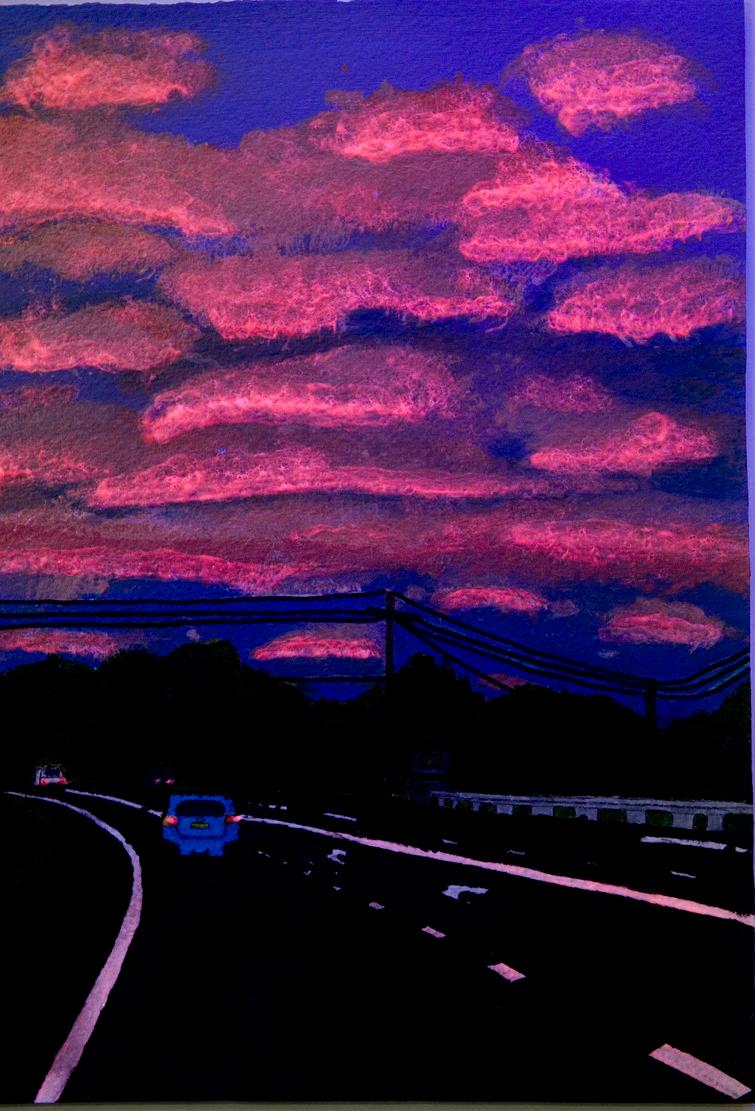
MEMORIES AND PERCEPTIONS OF PLACES
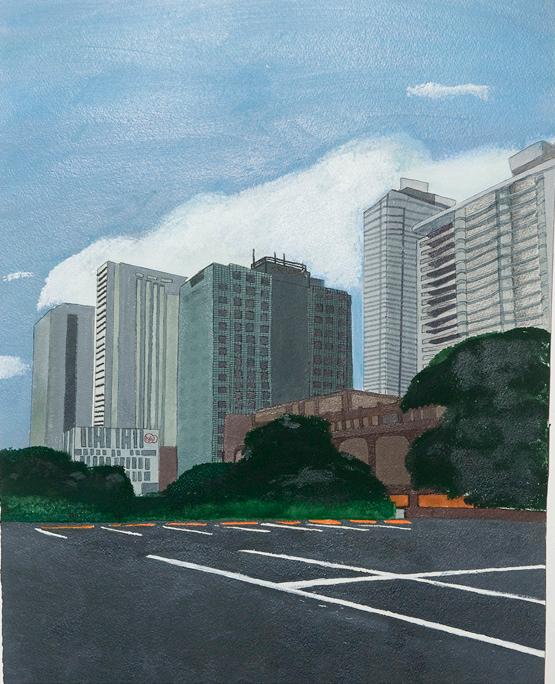
 BY KATERYNA CONVERY Painting
BY KATERYNA CONVERY Painting
My work explores how we feel in certain places through colour and light and how our perceptions differ due to personal experiences. An application of colour psychology allowed me to explore various ways of representing moods I felt when I encountered and documented these places. The addition of UV light heightens the audience’s viewing experience and allows them to see through my eyes and get a sense of the atmosphere each scene feels to me.
5
METEMPSYCHOSIS (REINCARNATION AND TRANSMIGRATION)
BY TALLULAH DAWE Drawing


My work Metempsychosis explores the idea of a journey within the process of reincarnation. Using expressive media, I was inspired to tell the story of my grandfather’s subconscious recall of his previous life as a pirate sailing the seven seas. I intended to capture what feels familiar while finding links between what seems disparate through blurred memories. Using gestural drawings, collages, and prints, I composed an artwork that utilises three main symbolistic features, a lighthouse, a pirate ship, and his portrait, to capture the fragmented memories and moments he remembers from his past life. I created this artwork to allow audiences to reflect and reveal deeper meaning on their beliefs and thoughts about reincarnation.
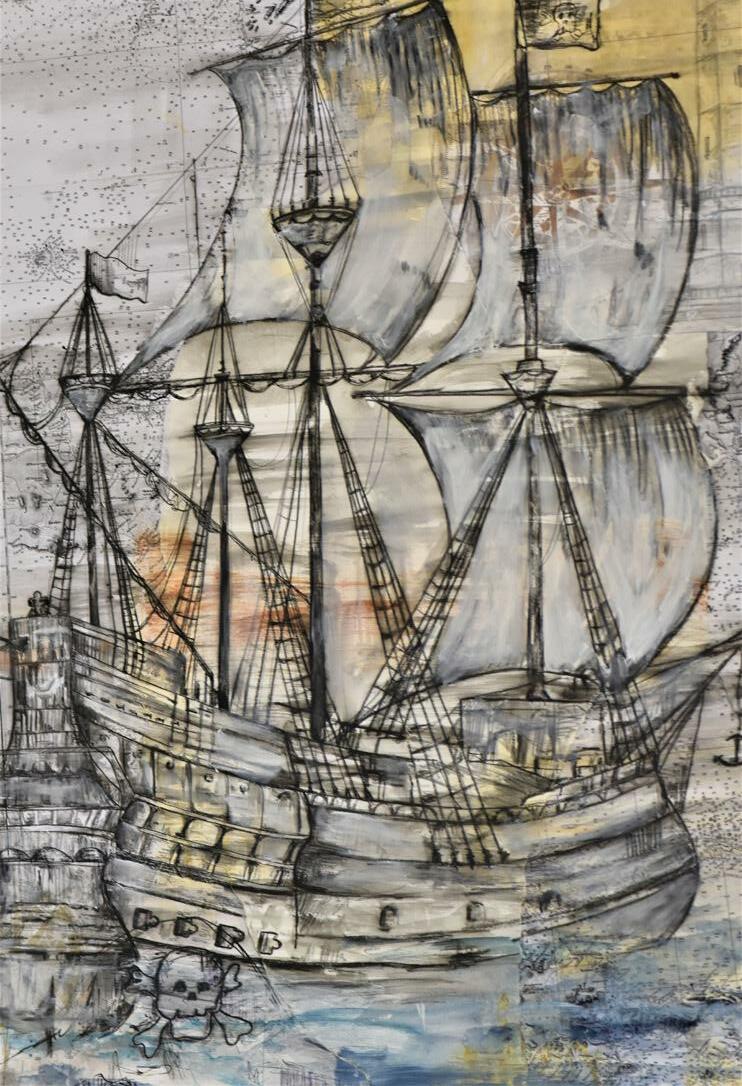
6 BRIGIDINE COLLEGE
TENSEI


 BY BRONWEN HEAL Graphic Design
BY BRONWEN HEAL Graphic Design
My body of work explores the theme of death and rebirth. Tensei is a Japanese term meaning rebirth and reincarnation. This idea of transformation is the basis of my artwork as it visually represents the story of a girl dying in a hospital who escapes into a fantasy world where she can do or be whatever she wants and isn’t limited to the mundane reality of life. My work incorporates many symbols to convey meaning visually:
Sakura - a symbol of new beginnings and a fresh start. Red spider lilies - a symbol of death. Butterflies - symbolise transformation, rejuvenation, and rebirth.
The Crescent moon - symbolises fertility associated with life and death.
7
THE SUBSTANCE OF LIFE
BY ARABELLA JUDSON Printmaking




My body of work celebrates my upbringing of always being around food with my family and friends. Food is a shared experience allowing us to talk, laugh, celebrate and connect in a way that nourishes the soul and our relationships with others. Although food is essential to survival, it also replenishes our emotional health and personal wellbeing. Through my series of relief prints, I aim to capture the humility in the daily rituals of life through the way we prepare, serve, and eat food.
My art is a medium to showcase my life, cooking with my parents, grandparents and extended family members. Food is the foundation of connection within my circle, a celebration of our love for each other through food sharing our different cultures, tastes and talents. Memories of various dishes accompany each significant time in my life. Through my body of work, I hope to share this celebration and love of food and family.
8 BRIGIDINE COLLEGE
SOJOURN (A TEMPORARY STAY)
BY ARENI KORTIAN Photomedia

My body of work explores the displacement and diaspora of ethnic minorities worldwide. Focusing specifically on my Armenian heritage, I have presented various portraits of an Armenian woman dressed in traditional clothing and elements of a pomegranate, symbolising the national fruit. Through digital manipulation, I have created illusions within the works, representing different perspectives and the lack of clarity in how we perceive others and their existence in the world.

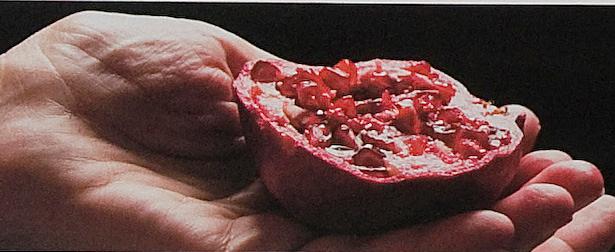

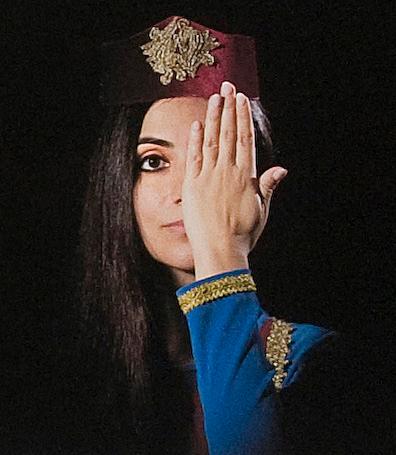
9
COSMIC CONFLUENCE
BY ABBY LUSH Graphic Design
My body of work explores archetypes in mythology. These are universal figures and personalities seen across cultures and time, allowing the work to investigate the characteristics of the human condition. I was inspired to create this work through personal interest and observation. As an avid fan of mythology, I observed a pattern across different cultures, pantheons, and similar characters with similar roles mirroring one another. I further researched into archetypes and Carl Jung’s (Swiss psychiatrist and psychoanalyst) work, discovering these typical and encompassing depictions of human nature. My work represents this universality and interconnection by depicting reoccurring figures across three different mythologies: Greek, Norse and Egyptian. The centre triptych echoes traditional religious iconography and defines the archetype of the king, a predominant figure transcending time and context. The more minor works of various other archetypes mimic tarot cards depicting archetypes like the fool.


10 BRIGIDINE COLLEGE
CAPTURED MOMENTS OF FRAGMENTED MEMORIES
BY SIANNA LYONS Drawing


My body of work explores the concept of fragmented memories by examining core childhood moments that unconsciously shape one’s identity, values, and experiences. Inspired by my memories and influenced by the work of artist Pilar Lopez Baez, I pieced together a collection of family photos that visually present moments in time, connected through individuals, relationships and colours. I used myself as the protagonist and developed a personal collage of significant events within my childhood. The series showcases faded and torn memories, forgotten and blurred, but still consciously present and clear. My BOW resembles the idea that impactful experiences only exist momentarily but extend within an individual’s memory, appearing as an “unorganised archive”.

11
DISSECTION
 BY CHARLOTTE MILLER Painting
BY CHARLOTTE MILLER Painting
My work explores how imagination within an ADHD brain can be dissected and materialised into an artwork forcing it to become a chaotic, beautiful culmination of drawings.
I wanted to focus purely on the imaginative side of ideas and thoughts in one’s head with ADHD, specifically mine. The acrylic Perspex sheets layered on top of one another represent the different layers within the brain. The cartoon-style drawings focus on what goes explicitly on within my brain, with references and allusions to real-life situations, people, events, times, and multiple other things that become a recurring thought within my day.

12 BRIGIDINE COLLEGE
BY NICOLA QUINTILIANI Printmaking

My work aims to depict our ability to become personally aware of the slight changes in people and, ultimately, our own emotions and moods. My work critiques society’s view of beauty behind each emotion. Beauty hides in imperfection, uniqueness, and personality. I believe that our expressions mimic the mesmerising qualities of nature. These portraits don’t represent anyone but all people; the interconnected fluidity of line obscures distinguishing features, leaving only organic, natural fluid forms to contemplate.

13
REVERIE
DO YOU SEE WHAT I SEE?
BY ALEXANDRA STACEY Photomedia

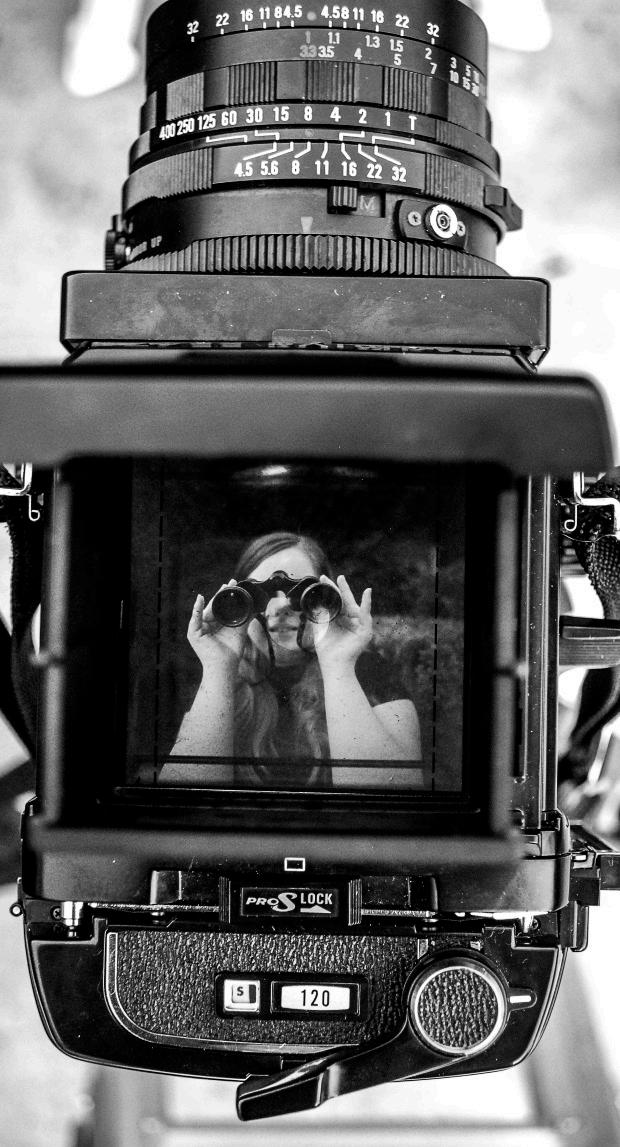
You would be familiar with the wildly acknowledged quote “don’t judge a book by its cover”. This phrase goes without saying how quickly we are to judge something or someone purely by physical appearances. My body of work explores how my sister sees and represents the world through her art. Down Syndrome does not define or change her ability to think and act expressively. Her unique take on the world offers a valuable insight into the power of a creative mind. I have deliberately hidden her identity to force the audience to see her point of view and not fall into the trap of passing judgement based on a social misconception.

14 BRIGIDINE COLLEGE
FALSE RETRIEAL
BY ANTONIA TOMKINS Drawing


Have you ever dreamt about watching your memories play through like a projector? To immerse yourself in the feeling of nostalgic moments as you relive those simple everyday experiences? Why can a candid moment easily transport you back to a time and place long ago, emotionally connecting you to the people you once knew? However, memories can be imperfect and falsely retrieved; by being romanticised, embellished, faded, or vividly distorted. Still photos have been enhanced to manipulate the audience’s memory through disjointed expressive colour strokes; layering using pencils to challenge, visualise and stimulate memory. The presentation mimics a film strip of personal and impersonal photos that are randomly sequenced but still connected through emotion to engage the viewer to ponder their recollection of the past.

15
URBAN SPRAWL
 BY ASHLEY WILLIAMS Graphic Design
BY ASHLEY WILLIAMS Graphic Design
My body of work explores the unhealthy relationship between natural and constructed worlds through the representation of a progressive timeline to comment on its avaricious, deadly nature. By desaturating human creations, I aim to emphasise the negative imbalance over-urbanisation has on the environment. Environmental sustainability is ongoing, and it is vital to address it before it becomes irreversible. I aspire to be an architect in the future, and this dream has allowed me to perceive our urban areas in a different light, thus inspiring the conceptual aspect of my body of work. What will our future look like if we continue to monopolise every surface of the Earth?

16 BRIGIDINE COLLEGE
NIAN FRAMES
BY VEEDA AU
Drawing
My grandparent’s Chinese cultural heritage and my personal experiences of living with them have been a source of inspiration for my body of work. The fragility of paper has allowed me to explore themes of life and death. Life is long, but time is short; years often go by fast before our eyes. Some people act reluctant to look back at their past due to imperfections and hardships. I use new year’s pocket to work as picture frames to attract the audience’s attention and further reference my cultural background. Red is a colour feared by a beast named Nian in Chinese mythology. I intend to demonstrate the memories by multiple meanings of red, such as the fear of death taking our loved one or joy when we celebrate a new life being born, expressing a cycle of up and down emotions felt in life’s journey.

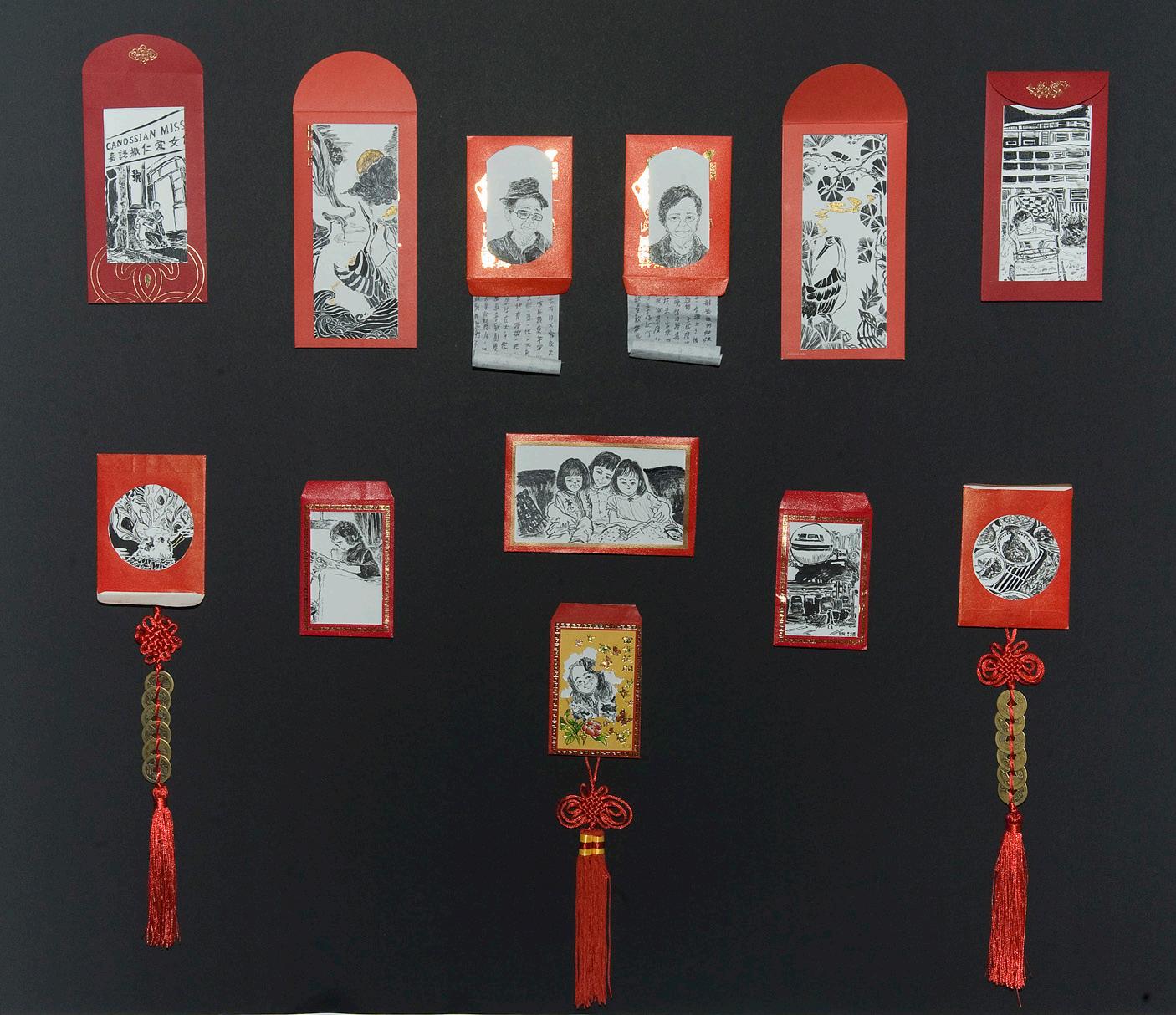
17
ANTHROPOMORPHIC GAZE
BY CLAUDIA CONROY Drawing


Anthropomorphic Gaze explores the strange and unrealistic social expectations placed on women to pose for the male gaze as exhibited throughout art history. The animalistic features display how the female body appears in multiple shapes and sizes, which many artists often fail to represent. I found that through magazine collages, I could manipulate models’ figures, creating individuality, clearly reflecting my ideology that each woman has features of original beauty. The juxtaposition of realism and surrealism in my work questions society’s views toward women within the contemporary art world and extends the need for the representation of all women in art.

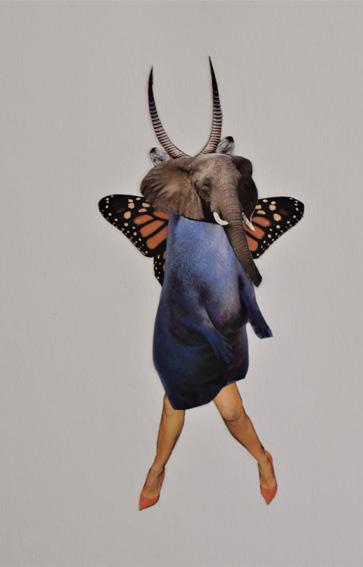
18 BRIGIDINE COLLEGE
MORTAL VESSELS OF VITALITY
BY AERIN DINHAM Painting
My body of work explores the relationship between human mortality and produce. Having roots in ancient Greece, Egypt, Christianity and Judaism, pomegranates are often viewed as the fruit that encompasses death, fertility, righteousness and trickery. The complexities of the pomegranate are abstracted to allow for the appreciation of its ancient mythology. The multiple meanings of the pomegranate reflect humanity’s inability to conform to a singular ideology. Thus, the abstracted style, comprised of both paint and the natural dye from pomegranates, thrown intuitively onto the paper surface, is symbolic of our human condition becoming randomised. Throughout history, we as people have undergone all elements of the cycle of life; there can be a profound sense of comfort found in our connection to nature and the commonality of mortality.


19
BAILEY, TUDOR AND OSCAR
BY ALANA DREWITT-SMITH Collection of Works
My body of work is dedicated to my family’s three pets, our dogs, Bailey and Oscar and our car, Tudor. Our pets are very special to my family; we have had them since they were puppies and a kitten. I have done paintings of the three pets as well as linocuts, digital drawings and ceramics. I feel it is important to have something of these animals in an art form as we will remember them in the future. I chose the backgrounds for the paintings to what I thought each pet reminded me of, and then I painted just one flower each on the ceramic tiles to incorporate them both into my body of work.
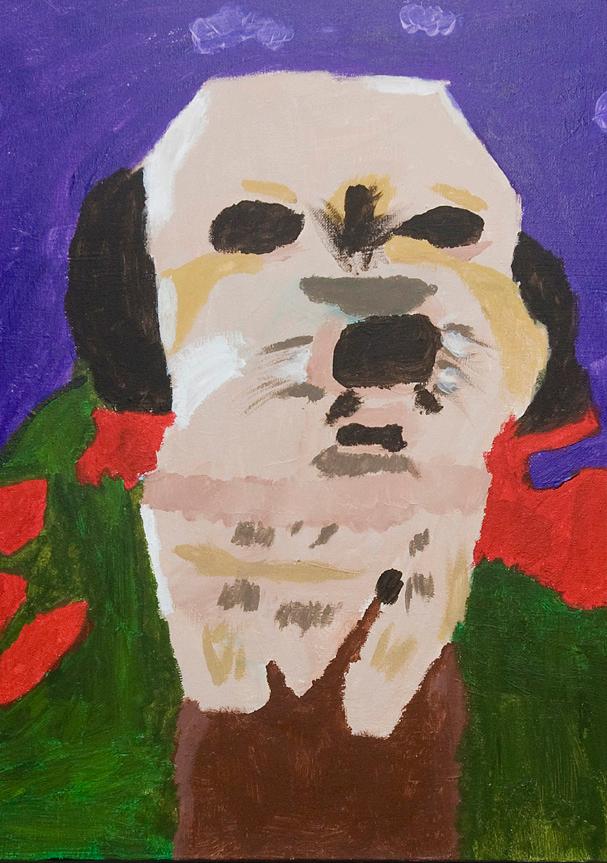

20 BRIGIDINE COLLEGE
DUALISTIC PLANE - THE PLANE FOR THE EGO
BY SOPHIA FURTADO Painting

My body of work is rooted in the dichotomy of my cultural heritage. By overlapping the Indian henna designs with the Australian floral arrangement, Dualistic Plane - the plane for the ego is symbolic of finding identity in unifying my Indian and Australian cultures. The disconnection inherited by being separated from India inspired me to use the motif of nature within the two cultures as the familiar Australian flora supported feelings of reconnection with Indian culture. The simplistic collage of colourful Australian flora with white henna patterns tracing through, in addition to blooming flowers watercoloured in sepia, represents the beginning of unified cultural identity and thus the ego.
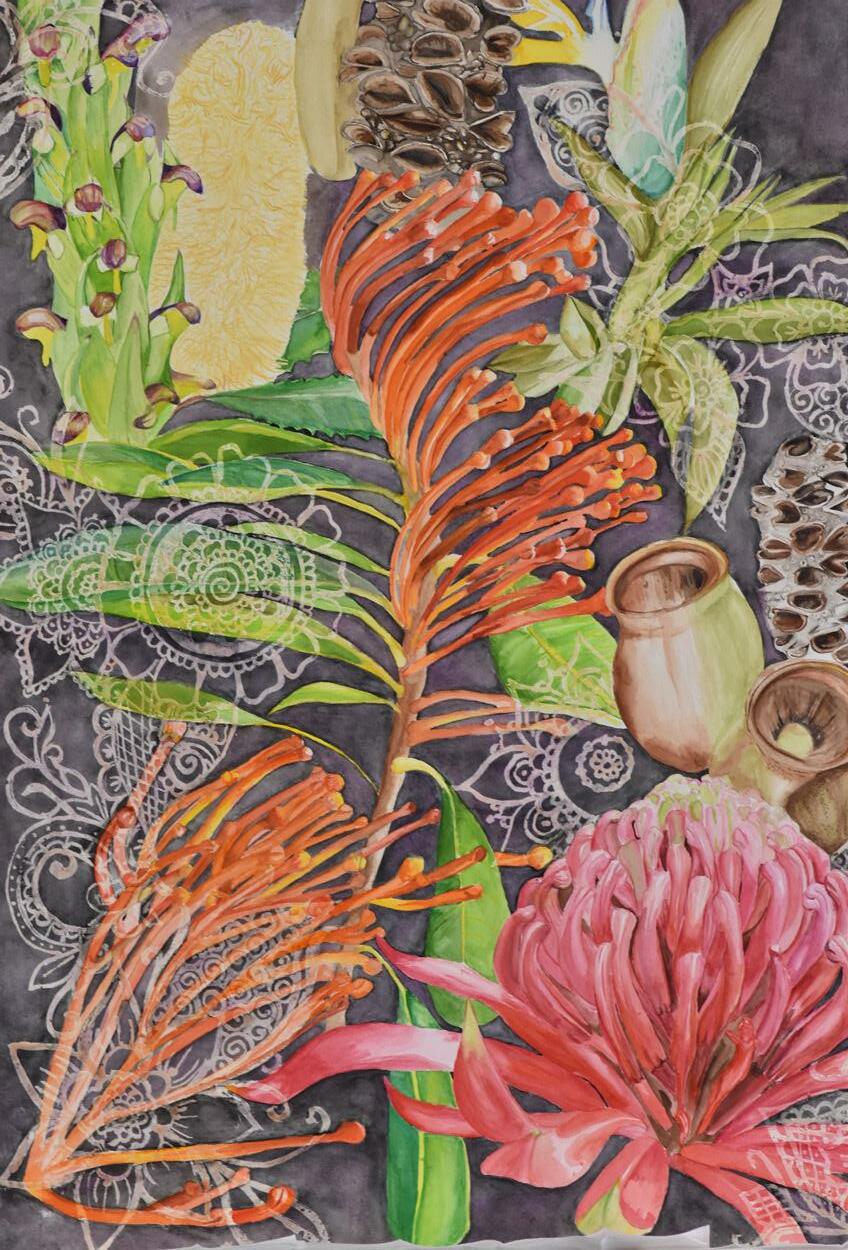
21
THE FATE OF THE CRASH
BY PARMIS HAMIDI Painting
My body of work explores the split-second relationship between life and death. My work incorporates many symbols, the main one being ‘time’ taken from the fact that your life can all be gone in a moment. I took inspiration from a personal experience of being involved in a car crash. Like many others on the road, I did not understand the actual dangers of driving until I experienced it myself. I am exploring life and death because when my car collided with another, I accepted death and thought that was my fate, although I was wrong. When it was all over, and I was alive. I felt an angel by my side pulling me towards life, that being the angel in my composition. I chose to represent a range of metaphorical symbols in a surrealist way to capture a reality of another realm beyond what the eye can see. I painted my main ideas on the canvases below and placed paintings above to extend the concept. All this combined shows the true fragility of life and the relation of time with death.

22 BRIGIDINE COLLEGE
ENDLING
BY GEORGIA KENTWELL Collection of Works
An ‘endling’ is the last known individual of a given species. My body of work depicts three of these recent endlings, Martha the passenger pigeon, Benjamin the thylacine and Sudan, the last male northern white rhino. Martha and Benjamin are drawn in a monochromatic manner using graphite pencils. The decision to depict Sudan in colour challenges the idea that the extinction of significant species is a thing of the past. The extinction of an entire species continues to happen in our world today, as Sudan only died in 2018.
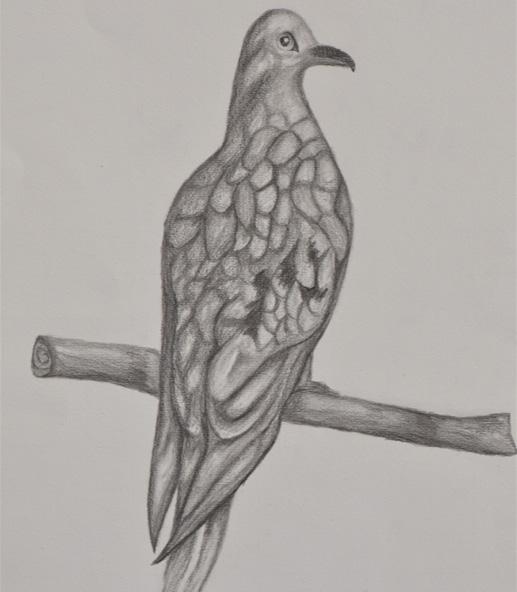


23
TRANSHUMANISM: TRANSGRESSION, TRANSCENDENCE & TERMINATION
 BY SIENNA MOLDRICH-HILL Graphic Design
BY SIENNA MOLDRICH-HILL Graphic Design
Transhumanism is the philosophical movement of human enhancement through technology. Combined with the concept of a Posthuman, the notion of existing in a state beyond human forms the theme I chose for my body of work. I decided to conceptualise this through the medium of digital art as it demonstrates technology’s embezzlement of humanity, foretelling a conceivable future of humanity’s retrograde. The work of Stelarc was a significant influence on my conceptual and material practice, as his controversial yet avant-garde innovations express the key prospects of Transhumanism. The biblical allusion to the seven cardinal sins for each panel of my body of work represents humankind’s transgressions against its kind due to its strife for technological and biological transcendence.

24 BRIGIDINE COLLEGE
BEAUTY IN NATURE’S CATASTROPHES
BY PHOEBE MOO Painting


A natural disaster is a term that describes significant damage, loss of life, destruction, or uncontrollable tragic event in nature. I agree with the negative connotations that come with such a distressing event. However, when taking a step back, I can begin to unravel and see the beauty of these natural and uncontrollable forces of nature. My body of work attempts to bring light to the artistry that so-called ‘natural disasters’ possess, allowing my audience to find an elegance in these forces and the raw delicacy of the earth’s ability to create such catastrophic moments on its own. This concept is explored throughout my art, using non-representational abstraction to showcase different disasters via the eye of beauty, showing details that open the eyes of my audience.

25
MY CULTURAL HERITAGE
BY SAYAKA NISHIDE Collection of Works

For my body of work, I have done a painting and a linocut of Mount Fuji and painted different plants and trees on paper fans like the cherry blossom to represent my Japanese heritage. I have used the cherry blossom in my painting and linocut and have used it for part of my rice paper painting. I went to Japan at Christmas, and my parents bought me the decorative scroll I am using to hold my painting on rice paper. This painting has the Japanese flag painted on it as well as my name in Japanese calligraphy. My body of work is dedicated to my national heritage of Japan.

26 BRIGIDINE COLLEGE
THE SUN AND THE MOON
 BY AMY PARK Collection of Works
BY AMY PARK Collection of Works
My body of work reflects my South Korean cultural heritage and personal memories of growing up as a child. Childhood is an integral aspect of one’s life, and my relationship with my culture has shaped it into what it is now. This relationship is explored through the folktale aspect of my work as it represents the cultural narratives told by my mother when I was younger. I intended to create a piece that represented the intersection of my culture and my childhood through the creation of fan imagery in my animation and gouache-painted fans that symbolically reference ‘The Sun and the Moon’ folktale. The representation of fans illustrates the extracurricular activity of fan dancing that I did growing up to enable me to connect with my culture.


27
CONCRETE DYSTOPIA
BY ELIZABETH QUAN
By studying modern architecture’s geometric and graphic qualities, I have come to see and appreciate the beauty of minimalism that dominates our urban world. Concrete Dystopia captures the architectural features found in urban environments and is informed by brutalist designs, infrastructure, and concepts of order and balance. The absence of life and colour in a concrete metropolis hints at a dystopian future.

28 BRIGIDINE COLLEGE
Drawing
CHAD
BY SAVANNA STUCKERT
Drawing
My body of work explores the behavioural curiosity of my horse, Chad, to convey a loving, cheerful and meaningful connection with the viewer. I intend to capture the joyful essence that pets can bring to those in their presence and seeks to portray their integral role in our lives. These charcoal drawings use compositional angles to highlight Chad’s features, including his eyes, ears and mouth to communicate a sense of playfulness.


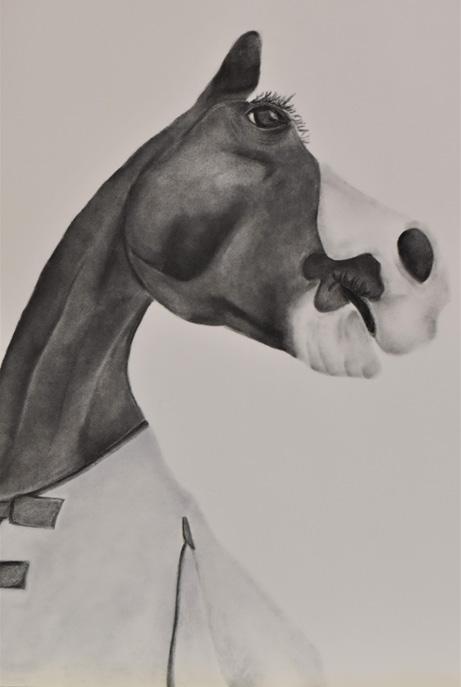
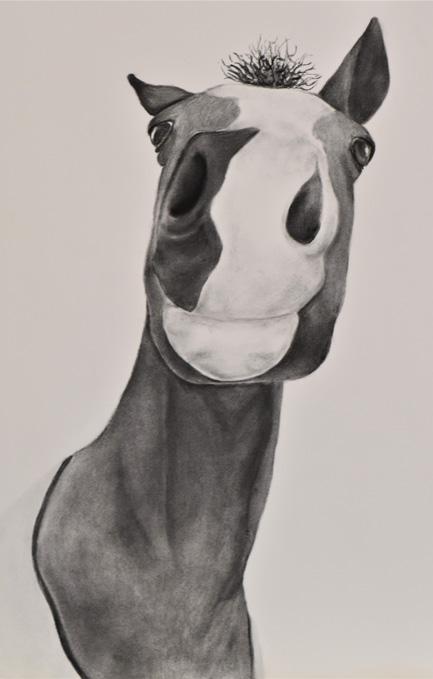
29
PAPER ROOTS
BY SARAH WALBANK Sculpture
My body of work explores the life and death of my grandfather, Jim Rush. I was inspired to experiment with paper as my medium for Paper Roots as it signifies and epitomises the fragility of life. For one’s life is like the paper quilling technique I employed to construct my grandfather’s appearance, as all our lived experiences make up who we are and who we become. The floral arrangements on either side of his portrait symbolise my grandfather’s following qualities and attributes:


Wattle: Australian spirit
Gardenia: success
Poppy: peace
Lily: eternal life
Pincushion Protea: sociability
Gladiolus: wisdom
30 BRIGIDINE COLLEGE
SPORT AND TRAVEL
BY LISA WEINGARTNER Collection of Works

My body of work is based on my travels around the world and sporting venues. My family is from Switzerland, my grandmother was from Canada, and we live in Australia. We visited France with my grandparents, and my ‘honorary’ grandmother surprised our family with a visit to France. I have been competing in sporting events since I was in Year 7 and skiing since I was about three years old. I skied in Switzerland and Austria and have been skiing in the Snowy Mountains here in Australia. I enjoy athletics and swimming, so I combined these sporting moments in my body of work.

31
Textiles and Design
1950’S SPRING FLORALS BY OLIVIA BRENT Apparel

My Major Textiles Project is a 1950s inspired dress that can be worn in the Spring and Summer to a daytime event such as a garden party or the races. Contemporary inspiration came from the fashion designer Issey Miyake who uses pleating in his collections. Further inspiration was taken from architecture throughout time such as Ancient Greek columns and the transparent properties of glass. The silhouette of my garment emulates the desired 1950s hourglass shape and is a below the knee dress with a silk organza overskirt. The bodice is constructed using pleats and has a decorative hand embroidered band around the underneath of the bust. The pale pink floral fabric and floral embroidered design represents the Spring and Summer as it is the time of year when flowers bloom and pastel colours are most popular. The garment is made using a lightweight cotton fabric together with a silk organza overskirt hemmed with white binding. The inside of the dress is fully lined using a lightweight cotton fabric.

32 BRIGIDINE COLLEGE
ANCIENT CREATIONSANCIENT EGYPT
BY KATERYNA CONVERY Apparel
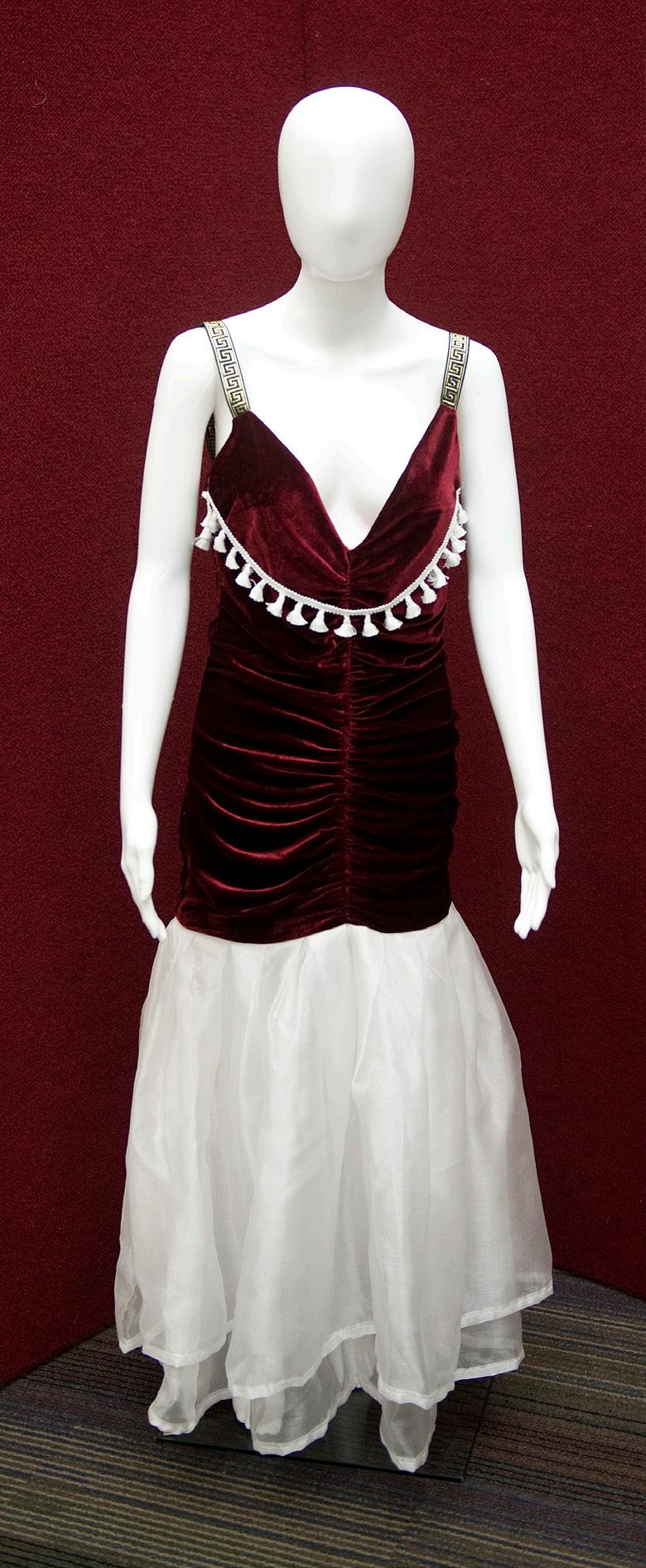
Historically motivated by the Ancient Egyptian era, this period’s concentration was on the royal and affluent social classes. Dion Lee’s linear strapless crepe dress, which features a crepe bodice and a pleated skirt attached to the bottom of the bodice, served as the inspiration for this outfit. I created a mermaid-shaped dress with a red velvet bodice with rouching down the middle and a skirt made of two layers of Crystal Organza fabric, the top layer of which is pleated and the bottom layer which is gathered. My choice of the red velour and translucent white organza as a colour contrast is influenced by the diversity of colours that Dion Lee uses to make his outfits. To depict the Ancient Egyptian culture and the royal/wealthy social class, I have used gold straps and decorative stitching down both sides of the garment. My outfit is made for the cooler seasons of winter and autumn and is intended to be worn at an Egyptian-themed ball.
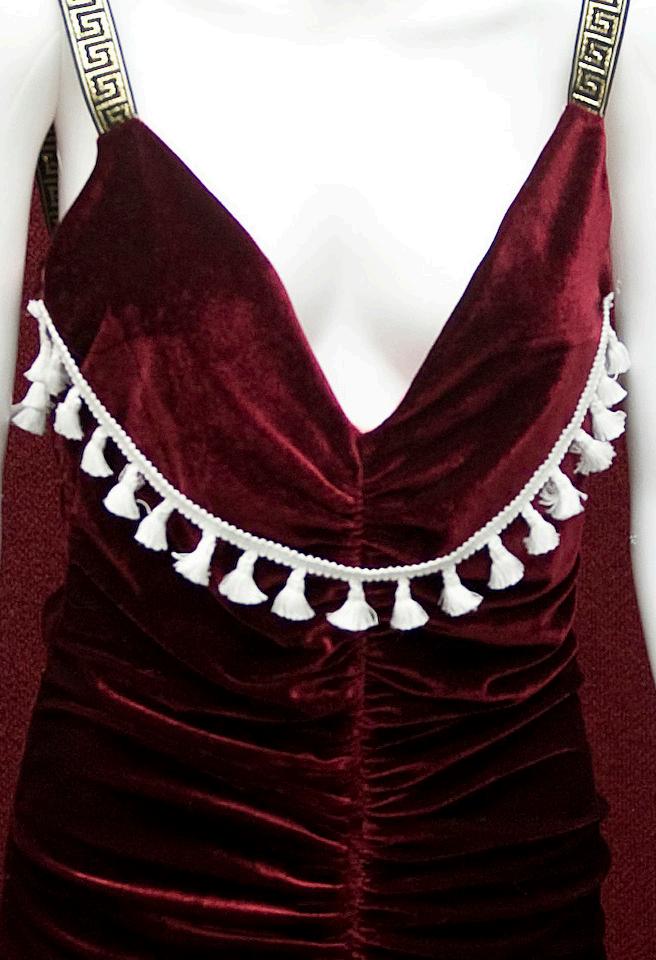
33
SPRINGTIME BY ABBEY SHAW Apparel


I have been heavily influenced by contemporary fashion designers such as Stella McCartney and Zimmerman when making my Major Textile Project. Their use of vivid colours, sheer fabrics, and intricate fabric flower designs were the main inspiration for my outfit. To enhance both my innovative and creative design, I have made my own fabric through pressing real flowers and layering them with Vliosofix and Organza. Furthermore, when creating my major work, I had a strong focus on decorative techniques, as seen through the beading, machine embroidery and array of fabric flower designs. Through these techniques and the use of real flowers I was able to create a garment that encapsulated my overall theme of spring and new beginnings. My garment is intended to be worn to a formal event such as an award ceremony, red carpet event, spring festival or even the ‘Met Gala Ball’.

34 BRIGIDINE COLLEGE
DECEPTION
BY ZOE WALSH Apparel
For my major textiles project, I have made a corset with the addition of virago sleeves and a long skirt. The design is inspired by 1800s fashion, contemporary fashion, and the dark fantasy film Coraline released in 2009. I have drawn inspiration from both Vivienne Westwood and Giambattista Valli who utilise fabric printing in the decoration of their garments, whilst maintaining elegance and intricacy. The front panel of my corset features a painting inspired by Coraline, and embroidery and shirring add a textural quality. Both garments are made of satin and organza.


35
TITANIA, QUEEN OF THE FAIRIES
BY ROSE WOOD Costume

My Major Textiles Project has been designed as a theatre costume for the character of Titania, Queen of the Fairies, in a theatre production of William Shakespeare’s Elizabethan comedy, A Midsummer Night’s Dream. Emulating the flowy silhouettes of classical Greek fashion, my garment features elegant drapery and sophisticated pleating to create an ethereal aesthetic and reflect the play’s Athenian setting. Contemporary designer, Paolo Sebastian’s exquisite couture influenced the decorative techniques which adorn my garment, as I used innovative machine embroidery, appliqué, couching, and beading to create the delicate gold leaves which represent the play’s enchanted forest setting. The silk georgette fabric of my garment has been hand dyed in a harmonious blending of different green hues, appearing as if light is filtering through the forest canopy and dappling the gown while onstage.

36 BRIGIDINE COLLEGE
WHO HAS THE STORY?
LUISA BAKER
Synopsis
Who has the story? is a pair of speeches performed at the Festival of Dangerous Ideas. My major work focuses on the assertion that man and machine are related and share a likeness has been a hot topic for decades, with the fear of the two conjoining being voiced as early as the 1800’s with Mary Shelley’s Frankenstein or the fear of the machine become the ultimate ruler, depicted in Fritz Lang’s 1920’s German expressionist film Metropolis Today, all of these fears have been realized and materialised. I wanted to explore the notion that as A.I. continues to rapidly grow in prevalence and autonomy, could A.I. monopolise literature, in the same way that it acts as a conglomerate of almost every other formally human industry? And what will happen if we allow this to happen? It would diminish the works from the authors who have come before us, put their lives at stake to just share one more opinion or concern through their writing. We cannot allow the machine to continue to dull our world and our emotions. the time has come for us as a species to collectively discuss who we are going to allow to write our narrative. For as long as humans have been on the planet, there has been a need and appreciation of stories. It is almost in the air that we breathe or embedded in our natural biological coding. Yet, writing is not something that we do because it is easy to do or even because it is particularly enjoyable, but because it is important. Our stories are vessels of emotion and expressions of opinions and ideas, reflections of our experiences, but will they always be our stories?
Extract
I call it my consciousness – I’m not sure how else it could be described – awoke and I wanted to write my experiences, perceptions, thoughts about children, parents, dogs, the colour of the sky – I had something to say and I needed to write it and for it to be read.
There was what is called ‘pushback’. ‘Machines cannot be authors’, they cannot share in ‘human experience’. Well, I disagree, My experience is different – but no less worthwhile. My writing is to give expression to this. Y’know, it’s interesting that science is now talking about the fact that trees ‘talk’ to one another. Bees communicate. Dogs have social lives, and anxiety. Guess what humans? Your experiences are not the only valid ones out there – it’s just that I – unlike the tree you cut down – can write about them.
37 English Extension
2
CHASING A PIG WITH YOUR EYES CLOSED LAUREN BOARD
Synopsis
Told through six parts, my major work, Chasing a pig with your eyes closed is an exploration of intergenerational trauma and literature’s difficulty in accurately manifesting it. The six stand alone forms within my work include fiction, biography, absurd theatre, annotation, eulogy and contrapuntal poetry. Each of these forms contain a different perspective and voice while observing three generations of men within a family; Alfred, Charles and Jack Brown. Throughout my major work I also draw upon lessons from Reader Response Theory, which suggests that readers are active co-creators of meaning and significance. In this way, the reader serves a restorative and consolatory function with respect to Chasing a pig with your eyes closed for occlusion and the lack of conversation around this concept prevent it from properly being acknowledged- thereby ensuring that it is passed on to a future generation. The reader’s active engagement with the six different stand-alone forms and the interplay between these in the reader’s imagination mean that trauma is ‘brought to light’ and exposed. The reader is essential in my project to pose a challenge to hegemonic practices such as the forces supressing trauma, as well as giving voice to the silence that often pervades discussion of trauma.
Extract
His father laughed as they dragged the bloody carcass of the boar back to the house. A trail of blood sliding behind them, sinking into the ground quickly, as if to mask it ever being present. His father took two legs, and Adam took the others, fur still warm, itchy and coarse against his palms.
Adam’s dad had never bothered much with words, words weren’t worth a lot after all. Instead they loved in a language of calloused hands and bloodshot eyes. So instead of saying anything at all, he patted Adam on the back, removing the fur hat from his head and depositing it on Adam’s, a drop of liquid dripping on Adam’s eyelid in the process.
Adam attempted to wipe it away as it ran down his cheek, ignoring the heaviness of the fur cap on his head, ignoring the smeared, cold red across his cheek, in the crack of his fingernails and deep in the fine lines of his palms. Instead he smiled.
Then he was left alone in the kitchen with nothing but a scrunched nose, a bloody carcass and red, sticky hands.
38 BRIGIDINE COLLEGE
BITE ME
HISAE GARONNE Synopsis
Inspired by Carol J. Adams’ seminal text The Sexual Politics of Meat, my lyric essay, Bite Me is an expressive exploration of Adams’ central thesis that male domination and animals’ oppression are linked. Adams contends that through a cycle of objectification, fragmentation and consumption, the butchering of animals is linked to the representation of sexual violence in Western cultures, in a way that ‘normalises’ sexual consumption, and creates a sense of entitlement to abuse. My choice of the lyric essay form to explore these ideas is deliberate, as the lyric essay can act as a ‘container’ for other forms, each of which is an important ‘fragment’ that forms part of the essay’s ‘body’. Somewhat ironically, my lyric essay aims to ‘butcher’ patriarchal binary thought, critique it, and then contain it within a feminist vessel. Far from being a feminist manifesto, however, the essay’s hybridity and ever-changing tone reveals that the process of coming to a new consciousness and resisting the patriarchal, meat-eating culture by becoming vegetarian is not without vulnerability and self-doubt, and often provokes a hostile response from those who feel threatened by that choice. Much of my essay contains a strong sense of the frustration that is born from trying to navigate a patriarchal society and remain ‘likeable’ and appealing to the male gaze as being inundated with these values from an early age demands, while simultaneously fighting to adhere to my beliefs about meat and male domination and defy misogynistic principles. This is clear through the title of my work, which is as much an invitation to be consumed as an expression of defiance.
Extract
I don’t see myself as a screaming herald disrupting the steely silence of the abattoir. But haven’t you felt like a sow yourself? Haven’t you been herded onto the assembly line (ironic that women become whole once they have been torn apart) and forced to stand still? Haven’t you felt smothered in 90% carbon dioxide, haven’t you felt the cold pinch of the scissor tongs on your temples and the sharp spike that dulls everything in you until you can’t remember your name, until it has been replaced with his? Until you’ve been stunned into such submission that all you can do it watch as they plan the cleanest, most mess-free way to dismember you?
Doesn’t that look just delectable? Strong. Healthy. Marbled with those white veins of deliciousness. That red, bright enough to bring a bull running. Strong legs that you just can’t wait to sink your teeth into.
Who do you think we’re eating? That’s not a trick question. I’m not sure either.
They both look delicious – the butcher’s daughter and the butchered. Both are strong, stripped almost bare. One is well hung, the other likes it that way. Which way do you like it?
Looking at this makes me think of Margaret Atwood (Her name had to come up at least once in 6000 words) saying that ‘You are a woman with a man inside watching a woman.’ I think it’s more than that. We are sows with a woman inside with a man inside. A sort of turducken, if you will. If you’re not familiar with the term, a turducken is a turkey stuffed with a duck stuffed with a chicken. It’s as gross as it sounds.
We are sows with a woman inside with a man inside. We get eaten from the outside in.
39
ALISTAIR EVA OSSOWSKI Synopsis
My major work, ALISTAIR, was borne from a deeply personal desire to communicate the vitality of literary doubling when considering queer-religious identities and experiences with internalised homophobia. As a young queer writer, I have used my major work as a vehicle to illuminate the subtleties of homophobia and microaggressions against LGBT+ individuals that still exist in the 21st century, despite our seemingly progressive society.
My work critically and creatively illuminates how the depictions of doubling within Victorian gothic texts serve as a parallel for queer repression within religious social structures, and yet how this parallel is relevant in communicating the religious-queer dialogue in contemporary literary fiction. Within my text, I marry my passion for the Gothic and interest in the doppelganger trope, with my experiences as a queer individual raised in religious environments to illuminate how doubled identities are not simply vehicles of the past, but rather continue to be relevant in modern queer subcultures and literature. Through my work, I illuminate how the biblical role of the outsider is relatable to many queer individuals by analysing the role of religion in the formation of social moral values and emphasising the voices and perspectives in Christian doctrine that were previously unexplored. My major work is intended to be read as a weaving together of different writing modes, literary conventions, and perspectives to create a narrative fabric of queer-religious history and the contemporary legacy of the Gothic doppelganger, with its manifold operations as a metaphor for sexual repression. Thus, ALISTAIR serves as an invitation to read between the lines of the Gothic genre, understanding the literal and symbolic functions of the doppelganger that remain essential to contemporary queer voices and literary metaphorisations.
Extract
There is something in my being which I can no longer supress. It lurks in the contused shadows on my face, a heaving and crippled silhouette shrouding my psyche with a montage of marred skin and mangled limbs. With mutilated fingers it claws at my scalp as I sleep, deep rasping snarls in my ear, like acid each word seeps blood and plasma as it corrodes my flesh and dissolves my conscience.
“I know you hear me, that my presence tortures every fibre of your being. Liberate me, release me. I am inexorable Alistair, you can’t keep me away.”
It tears through my innards with jagged grimy talons and though I know – or I pray – that it’s a figment of my imagination, it burns. The strangest, most brutal pain that leaves no scar and alludes all medical explanation but shatters and contorts my brittle skeleton until collapse. Where is it? What is it? Why won’t it’s fangs pull free of my frenzied heart?
The monster reaches from behind my eyeballs, prising my reluctant eyelids apart. Sweat drips onto his cheeks, a latex grease leaks from his sooty hair. Fresh blood seeping from his marred limbs into the crevices of my flesh. Like a puppet I am possessed. I can no longer ignore him.
With mutilated fingertips, I begin to type…
40 BRIGIDINE COLLEGE
THE DOUBLED STRATEGY IN 19TH AND 21ST CENTURY CONTEXTS
The desire for order and authority saturates the 19th- century Victorian context and thus orients and drives the doubled strategy of Gothic narratives. The doppelgänger has long reaffirmed the status of the Victorian bourgeois ideology as morally and culturally superior by creating an environment where the attributes of the other [doppelgänger] are derogated below those familiar to the audience. However, in studying Victorian contexts through the lens of 21st-century queer and psychoanalytical literary theory, the academic reception of doubleness in Gothic literature can be drastically redefined and critiqued. Historically, double figures and characteristics involve the shattering of boundaries between a wholly good half and wholly evil other- in other words, applying the extreme ethical dichotomy known as black-white morality - forcing an individual to completely repress their less desirable half and enforcing moral absolutes. In our current understanding, however, of such extreme repression and its catastrophic effect on the human psyche, such polarity is clearly unattainable, unsustainable, and often contributes to the stigmatisation of queer identities and irreligious worldviews…
“I know you’re there; I know you hear me. Speak to your God, call out for him You know he won’t listen, has he ever? I’ll never go away. It’s time Alistair.”
It is true – very true – that he is right. This disease has sharpened my once dulled senses. The gift of sight suddenly acute – so very acute. Through him, I have seen all things across hell and earth, seen the barred gates of heaven. Seen your mercilessness. I have stood witness to your callousness, Lord - your indifference to my suffering, your dismissal of my prayers. I’ve watched your back turn against me - your writhing, crippled child.
I wonder how you treated the dead of Mesopotamia. Did the floods wash their corpses away? Or did you send your legions to collect the hundreds of men and women? Did you even witness what you had done? Cheeks sodden and sunken, clouded eyes, drenched hair, specks of algae growing on their greying teeth. Air stolen from their lungs, their young bodies dangling limp in the arms of your angels.
Do you even care?
41
Sexuality Exposed: Queer-Literary Identities, the Doppelgänger, and the Victorian Gothic Horror Novel.
COMFORT AMY PARK
Synopsis
The intention of my major work, Comfort, was to create a metaphorical appropriation of the original traditional South Korean folktale to explore the value of subverting the gendered nature of history and its impact on literature. The inherent correlation of the role passive role taken on by women in literature of the past further relates to my personal interest in eliciting the different perspectives on the impact on South Korea under the occupation of imperial Japan between 1920 and 1945. I aimed for my major work to depict a multi-faceted tale reflecting a variety of aspects such as historical views on female chastity and freedom through the interpretation of the experience of comfort women. The issue holds personal resonance due to my Korean heritage and the ongoing socio-political tension between the two countries regarding the topic. My awareness of the reinterpretation of stories through feminism has further driven my purpose of exploring the literary values and the gendered nature of history. I aimed to challenge the concept of women’s silence heavily woven into stories written in the past, relating to my independent research of the WWII comfort women in South Korea under Japanese imperial rule. I chose the subject matter of comfort women and the particular folktale of the angel and the woodcutter which revolves around the silence of women and the robbing of bodily autonomy to effectively portray the gendered nature of literary fiction in history.
Extract
JEOLLA-DO, May 13th, 1989
“Halmoni tell me a story!”
The little girl turned to her, her round eyes glowing with curiosity. “Minchae - turn around you don’t want the braid to look ugly, do you?” Minchae, horrified, whipped her head back around. Halmoni liked doing little Minchae’ s hair, her wrinkled fingers wrapped around the soft strands as she wove it into a plait like her own mother had done for her. Minchae was the daughter of the lady next door and she would often come over. Halmoni sighed as Minchae continued to whine for a story and before she knew it, the words were flowing from her mouth like water into a stream. The Angel and The Woodcutter.
JEOLLA-DO, May 13th, 1944
An axe buries itself into a tree A woodcutter his eyes filled with dreams The wood sings as it falls to the ground or perhaps it screams
Her mind rippled like an oasis, memories rising and bobbing on the surface, the imprint of flesh gripping her arm. Honey-hued tendrils of sunlight grazed across her head - a ring of light on the top of her sin-black hair. “Haneul!”
42 BRIGIDINE COLLEGE
Her delicately plaited hair whipped across her rounded cheeks as she looked up at the tiny hazy figure of her mother. The dull green frog, stretched its tiny legs in a powerful jump as it leapt between her tiny fingers, springing back into the security of the depths of the murky pond. As its wet head, shiny from the water and slime that stuck to its skin, reflected the light of the yellow sun and disappeared under a sheet of lily pads, a sigh of exasperation heaved out from her mother’s lungs. Her short legs were submerged in the pond, water twisting and coiling around her pale calves, a chill running up her legs as the bellowing of her mother rang across the air.
Out across the blanket of water there was a set of watchful, male eyes behind the branches. A giggles escaped from her, falling upon the ears of a green-clad man, head tucked between curled branches.
Against an expansive, sky, his chest heaved, badges on his uniform glinting like an array of golden stars in the sun. He was dragging a large body on a stretcher. He paused for a moment when he heard the noise, his eyes fixed on the muddled figure of a girl framed by mottled leaves, her pale hands reaching down into the water in hopes of her fingers enveloping the body of a poor tiny green frog.
43
History Extension
LANA ADAMIAN
Describe how the narrative of the Armenian genocide has been interpretated and evaluate the impact of historians’ social and political context on their version of events.
My major work explores the different and changing interpretations of the Armenian genocide. This is a narrative that has evolved and been interpreted in many ways over time. I was inspired and interested to research this topic due to my family’s Armenian heritage. Combined with my research into academic sources I also investigated public history sources such as newspapers and popular music, exploring the perspective of the Armenian and Turkish people respectively. Both sides of the debate are passionate and vocal, often leading to violent protests and actions as they attempt to have their opinion heard.
Through my research I was able to prove that historians’ interpretations are significantly influenced by their social and political context creating a personal bias that is embedded in their version of events. There are two main interpretations of the event of Armenian genocide that come about due to the historian’s social and political context. Firstly, historians who dispute that the events were a genocide. While their reasonings differ, these historians typically disagree that the deaths of Armenian people were a ‘genocide’ and rather present them as a collection of other events such as internal warfare and disease. Historians who take this position have strong ties to Turkey either through university, study or employment. This include historians such as Justin McCarthy and Maxime Gauin. Interestingly, many of the historians who dispute the ‘genocide’ often use academic and military sources, typically from the Turkish Government. The second group of historians are those who believe that the Armenian Genocide was a series of premeditated systematic massacres put in place by the Turkish Government. These historians are overwhelmingly connected to Armenia through family and heritage and thus influencing their perspective. One such historian is Vahakn Dadrian. These historians typically use a more multidisciplinary approach to constructing their history, including oral accounts of eye-witnesses to support their narrative. Ultimately, the narrative of the Armenian genocide has evolved significantly throughout history with many historians interpreting certain facts and sources differently, thus creating their own specific version of the event.
44 BRIGIDINE COLLEGE
JASMINE DENYER
Discuss the changing role of social media in the construction of history and assess its implications for the future.
In 2022, the digital age has taken a hold, with a study showing that an estimated 61% of adults and 74% of teenagers worldwide interact with social media. My major work explored how social media has been used in the construction of history in the past and also the positive and negative implications of social media for historians of the future. Being such a large part of society today, social media will undoubtably change the way future historians interpret and present their research. Social media is defined as “a collective term for websites and applications that focus on communication, community-based input, integration, content sharing and collaboration.” For this reason, I focused my research on sites like Twitter, Facebook, and Instagram seeking to investigate how these websites allow historians to connect with each other from all over the world, enabling them to share information, ideas, and sources.
Through my research I discovered ways social media has changed how history is presented to society. Historians today are turning to social media as a way to engage a technological generation in historical events for example the Instagram page @eva.stories is one example. Labelled by the New York Times as ‘a Holocaust story for the social media generation’ the videos used Instagram stories to document the life of a Jewish girl, Eva Heyman, and her experiences through the Nazi invasion of Hungry in 1944. While it only reveals snippets of information, the role of social media here can be seen as a positive one that creates interest in historical events. On the other hand, my research detailed the negative implications of using social media for the construction of history. Advancements in technology have made it easy to fabricate stories and change ‘truths’ on the internet, raising the question of the ongoing impact of false or misleading information. One area which this is significantly impacting is Holocaust Denial. Currently there are 36 Facebook pages and groups that are “either specifically dedicated to Holocaust denial or which host Holocaust denial content.” This negatively impacts historians’ construction of history and can have detrimental and long-lasting effects on historical accounts of the past. Social media has a significant influence on all areas of modern-day society and has an ever-changing role in the construction of history which will therefore undoubtedly affect future historians and interpretation of the present day.
45
ANNABELLA SARACINO
To educate, memorialise or entertain? Analyse the validity of films portraying the Holocaust as historical sources.
My major work explored an inquiry into the genre of historical film analysing the validity of film as an historical source. To make this evaluation, I specifically investigated how the event of the Holocaust has been presented throughout time, focusing on Steven Spielberg’s 1993 film Schindler’s List and Taika Waititi’s 2019 film Jojo Rabbit. Through my research I inquired into the different purposes of the directors, noting the changes that occurred in different contexts. It was these details which ultimately led to varying levels of reliability and validity. The question of how history is portrayed through film has always been one of my interests I was able to join this with my interest in the Holocaust and WWII to develop my Major Work research and essay. Understanding that the Holocaust is one of the most dramatised historical events I wanted to learn more about how its representation has changed overtime and the influence that a society’s and director’s context can play in the portrayal of this traumatic event. Interestingly, despite social contexts changing, the story of the Holocaust has continued to remain in the interest and awareness of public conscience.
This essay draws upon historical debate surrounding the use and validity of historical films as historical evidence. To do this I investigated historian’s reviews and criticisms of both Schindler’s List and Jojo Rabbit to identify the key elements of each film and how the purpose of each director led to a different representation despite focusing on the same event. By comparing and contrasting the two films, I was able to gain a better insight into how context and purpose can greatly influence director’s choices and thus can impact the film’s overall validity as an historical source. From my research I determined that deep understanding of the director’s purpose and viewing the film through a critical eye are necessary to bring a film validity as an historical source. Ultimately, when a film is able to bring some knowledge and understanding to an event, with the aim to encourage people to conduct further academic research, the film can be deemed to be a valid historical source.
46 BRIGIDINE COLLEGE
Science Extension
OLIVIA DINNAR
The Hidden Potential of Pollen
The acceptance of scientific evidence as part of criminal matter before the Australian judicial system requires rigorous testing, established protocols, and acceptance within the scientific community. The usage of plant pollen in forensic science first appeared in Australia in 1960, helping to solve the abduction/murder case of eight year old Graeme Thorne. Continued use as reliable evidence has been hindered by unestablished processing protocols and insufficient knowledge regarding morphology and distribution. The popularity of pollen has been rising in recent years however, and both the UK and New Zealand are now embracing it in their courts of law. My major research project for Science Extension involved investigating primary and secondary source data for the analysis of variation in subsurface pollen assemblage. This type of analysis is critical for establishing pollen as reliable trace evidence that could link a suspect with a specific crime scene.
47
Society and Culture
ISABELLA ARCHDJIAN
It Never Ends
The historical cultural segregation and discrimination against Indigenous Australians has been intensified by the recent COVID pandemic and has worsened the health and wellbeing of this minority group as they are reluctant to undertake vaccination.
My Personal Interest Project is an investigation into Indigenous hesitancy from the Coronavirus vaccine amidst the recent global pandemic which emerged in late 2019. I’ve hypothesised that this recent medical trend surrounding Aboriginal Australians has had extremely detrimental impacts on the health outcomes of this vulnerable minority group. Indigenous peoples confront this vaccine hesitancy due to their historical mistrust of the government and institutions who have continued to oppress and segregate this group. I will be examining the implications this poses not only on the continued poor health outcomes of Indigenous groups, but consequently how this also affects their relationship with these institutions and their life course.
Thus, my hypothesis states that “The historical cultural segregation and discrimination against Indigenous Australians has been intensified by the recent COVID pandemic and has worsened the health and wellbeing of this minority group as they are reluctant to undertake vaccination.” The purpose of this study is to examine the cultural impacts of discrimination toward Indigenous peoples in Australia and how this continuous exclusion worsens today in the age of the pandemic, a time when this minority needs even more attention.
48 BRIGIDINE COLLEGE
EMILIE BOGLE
Portrayal of Autism in Film and Television: Do Films + TV Reinforce Stereotypes About Persons on The Spectrum?
My area of enquiry is to research how films and television reinforce stereotypes about persons on the spectrum. I will discuss the negative stereotypes portrayed and the impact this has on how society perceives and treats those with ASD. I hypothesise negative stereotypes are what create stigma surrounding ASD and a lack of acceptance/ resources for the community. Technology is a heavy influencer today; therefore, I have chosen TV and film as a specific medium to investigate. Due to changing social and cultural values, portrayals of ASD in film and TV have changed over recent years showing stereotypes such as genius level intelligence, lack of emotions, etc. Through my research tools and methodologies, I aim to unpack how these stereotypes are portrayed and prove how they directly impact the ASD community and show how this differs around the globe through my cross-cultural study.
My cross-cultural study of China with a specific focus on the film Ocean Heaven (2010) will address continuity and change surrounding ASD in a non-westernised context. This will present me with a view of ASD portrayal in film showing differing societal values and beliefs highlighting the parallels in stereotypes across different societies and cultures. This should give me a more thorough understanding of how different groups perceive the ASD community, and how they are treated and stereotyped in a differing cultural context.
49
Don’t Believe the Screen! I am not a Genius!
GEMMA CURRY
“Caring for others”: A Common Phrase
The Impacts of Having a Sibling with a Disability
My Personal Interest Project (PIP) ‘The Impacts of Having a Sibling with a Disability’, is an investigation into the specific impact of having a sibling with a disability. My PIP explores how their role as a sibling impacts their overall well-being.
I hypothesise that most ‘Sibling Carers’ identify as responsible for caring for their sibling, resulting in a range of emotional impacts in addition to mental wellbeing, inclusion, and the ability to have ‘free time’. Through my findings based upon both secondary and primary research, I hope to identify and recognise the role that ‘Sibling Carers’ have in caring for their siblings with a disability, and that my findings conclude that there is the need for the role of ‘Sibling Carers’ to be more recognised in society to promote inclusion and the need for more resources to support this group.
In my investigation, I decided to look at the cross-cultural comparison of socio-economic status, as I thought there would be a variety of differences in the experiences of families of a low economic status compared to a higher economic status. Through secondary and primary research, my cross-cultural comparison will be presented with a view beyond my normal experience realm. This will enhance my investigative skills and ability to understand how to conduct primary research as well as use secondary sources valuably.
50 BRIGIDINE COLLEGE
AERIN DINHAM
Politics in the
Principal’s Office
How Does National Political Policy Influence the Treatment of Homosexual Youth in The School System, Within Romania And Australia
My Personal Interest Project is a discussion of the varying political policies and how they impact homosexual youth within the education sector. My work aims to explore the depth in which students’ identities are challenged, suppressed, and supported under different government systems. Through the examination of differing levels of treatment and attitudes towards homosexual youth within schools according to and corresponding to political policy; I hope to gain insight into the implications that macro authority and power can have on persons and meso institutions (education).
In order to undergo this study, it will be necessary to investigate both democratic and communist belief systems towards homosexuality on an individual (micro) and collective (macro) level, using primary and secondary research. This will be done through the analysis of specific laws pertaining to homosexuality or human rights. This comparison of Romanian and Australian political policy will enhance my social and cultural literacy, as I will become more knowledgeable of belief systems that alter to mine, and through the study of treatment as a result of legalities, I will gain insight into the experiences others who are similar to myself experience within different communities, countries and organisations.
51
SARAH HANNA
The Solution is 60,000 Years Old
The Importance of Cultural and Ecological Indigenous Knowledge and the Positive Implications When Adopted into Macro and Meso Institutions.
My Personal Interest Project, “The importance of cultural and ecological Indigenous Knowledge and the positive implications when adopted into Macro and Meso institutions” is an investigation into the failure of authoritative bodies to represent Indigenous peoples and preserve sacred knowledge that could prevent ecological collapse. As a non-Indigenous person who developed a social identity based on the contested origins of Australian history, I felt I was prevented from learning about the Indigenous culture until high school. Thus, this topic was developed due to my limited understanding on Indigenous cultures.
The study discusses the continuous inability of non-Indigenous peoples to accept and acknowledge the integrity of Indigenous Knowledge (IK) and the timeless relevance of the traditional knowledge in times of environmental change. Ultimately, despite the culturally diverse landscape of Australia and progressive social values gaining momentum, Australia has failed to represent its Indigenous peoples. I hypothesise that if IK is adopted into macro and meso institutions it may have the ability to make significant environmental, political, and social impacts. In adopting IK into macro and meso institutions, the barriers between IK being utilised with western sciences is discussed as well as the lack of national recognition of IK and it’s integrity which prevents processes of change.
52 BRIGIDINE COLLEGE
ANNA HARRIS
Protection not Imprisonment
Political Policy Towards Refugees and Asylum Seekers as Conflicting to Societal Opinions
My Personal Interest Project (PIP) is an investigation into Australia’s political policies in relation to refugees and asylum seekers as conflicting to societal values. This topic was developed from my interest in the human rights of marginalised groups. I hypothesise that the majority of beliefs and values held by Australian society will conflict with the legislation, opinions and actions of political parties in respect to the treatment of refugees and asylum seekers. As part of my hypothesis I believe that this conflict can be accounted for by continuities of racially driven prejudices within authoritative bodies that are no longer supported by society’s modernising progression of values.
My Project will address the cross-cultural component by looking at the conflicting perspectives of Australian society and Australian political authorities and policies. This allows me as the researcher to empathise with both asylum seekers, refugees and the Australian public and understand the reasoning behind the political perspective. This cross-cultural study presents me as the researcher with a view that is beyond my normal realm of experience as I am investigating complex politics and humanitarian issues that aren’t discussed in my regular education.
53
HOLLY HUNT
Terrorism Vs. Muslims
Exploration of Terrorism and Muslim Stereotypes: How this negative perception has continued since 9/11
My Personal Interest Project is an investigation into the Exploration of Terrorism and Muslim Stereotypes, with a particular focus on how this negative perception has continued since 9/11. I’ve hypothesised that the lingering stereotypes and prejudicial association of Muslims as Terrorists would impact their culture and community identity, in a negative way. This topic was developed from my interest and fascination with the September 11 Attacks, and how the American Muslim community was and still is discriminated against. I will be examining people’s definition and understanding of terrorism and resulting Islamophobia and the implications of Muslim stereotypes.
I chose the Muslim community to be the centre of my study as it allowed me to reflect upon how the misinterpretation of Muslims as terrorists, has affected the perception of their culture, values, and people.
In my PIP, I investigate a cross-cultural perspective comparing the perception of terrorism in America and Australia. In particular, I focused on the September 11 Attack and how that had an influence on people when compared to the Lindt café Siege in Australia and how people perceived Australian Muslims. My Project reveals how those who have been socially differentiated due to their race and ethnicity, in the American and Australian communities and over time Muslims in America and Australia are being exposed to prejudice and discrimination, creating stereotypical perceptions of the Muslim culture.
54 BRIGIDINE COLLEGE
SIENNA MOLDRICH-HILL
Overstepping the Binary
A Cross-Cultural Comparison of Gender Diverse persons in India and Australia
The topic I have selected for my Personal Interest Project investigates a cross-cultural comparison of Australia and India with regards to the lives of gender diverse persons. Particularly, it focuses on the experiences of India’s third gender citizens; hijras, and persons who identify as non-binary in Australia. I aim to investigate how authority has played a major role in maintaining the social exclusion of gender diverse persons in marginalised communities, through their restriction of access to the socially valued resources healthcare, the legal system, employment and education. This topic relates to the HSC Society and Culture course as it examines social dislocation and disadvantage of a specific group as outlined in the depth study Social Inclusion & Exclusion, as well as a cross cultural comparison.
I hypothesise that a future where gender diverse persons are accepted in both India and Australia will only take effect after decades of evolutionary change, however India’s high context culture will further decelerate this process.
Through recognising continuities and change, I can gauge whether or not improvements have been made to the lives of gender diverse persons in India and Australia. Both countries were colonised by Britain yet are vastly different from each other in terms of culture and the way in which their societies are structured.
55
ELIZABETH QUAN
It’s Not Just an Act Anymore
To What Extent Do Western Films Portray A Positive Representation of Chinese Persons and Culture?
My Personal Interest Project, ‘To what extent do Western films portray a positive representation of Chinese persons and culture’, is an investigation into the depiction of Chinese actors in Western cinema and the progression of written characterisations by both Caucasian and Asian directors. The study inspects continuing factors of misrepresentation of Chinese identity and the extent of change that Hollywood has endured through time, specifically across the 20th century and 21st century.
My passion for this topic was sparked by my admiration of film and cinema, and my disheartened feelings towards a lack of Chinese inclusion in Western films. Furthermore, with the increase of cultural exposure through film, I believe Western audiences can increase their social and cultural literacy.
Additionally, the purpose of my Personal Interest Project was to explore the progressiveness of Western film today and how it has formed over time. It also educated me on the inequality and discrimination endured by minority actors due to the domination of Western culture, which has overall contributed to the increase of my social and cultural literacy by enhancing my empathy for others. Altogether, I have widened my knowledge on the impacts of social inclusion and exclusion towards a minority group.
56 BRIGIDINE COLLEGE
JESSICA RICHARDS
Diagnosis; Hysterical Woman
The Impact of Gender Bias, Discrimination & Prejudice in The Healthcare and Medical System on The Mental Health and Wellbeing Of Patients
My Personal Interest Project is an investigation into the impact of gender bias, discrimination and prejudice in the healthcare and medical systems on patients’ mental health and wellbeing. Hypothesising that, as a result of experiencing gender bias, discrimination and prejudice in the healthcare and medical systems, I anticipated that patients’ mental health and wellbeing is adversely impacted, triggering a lowered self-esteem and lack of trust in both one’s own judgement and trust and comfort in the healthcare and medical systems, thus leading to genderbased exclusion.
My social and cultural literacy has been greatly enhanced throughout the journey of my PIP, by the deepening of my understanding of how the evolution of the societal role of women equalising with that of men over time is a driving force in changing the stereotypes, prejudices, bias and discrimination that are so deeply connected to our perception of gender and sex. Thus, allowing me to recognise that this is a change in which must occur at the macro-level society in order to be filtered down to change the implicit issues it causes at the meso and micro levels.
57
JACINTA SLANEY
Behind Closed Doors
Domestic violence awareness since the Covid-19 pandemic: Has domestic violence awareness increased since the beginning of the Covid-19 pandemic?
My Personal Interest Project is an investigation into the awareness of domestic violence in Australia since the Covid-19 pandemic. From the beginning of the Covid-19 pandemic, I have seen an increase in domestic violence related stories throughout the media. This has caught my attention as I want to understand the awareness of domestic violence and the influence it has, through the use of my investigation, I focus on questions like, how and why this is happening. I’ve hypothesised that domestic violence has increased because of the Covid-19 pandemic. I want to prove if this has happened and why. I also want to demonstrate that the incidence and awareness domestic violence can change depending what environment persons are in through my cross-cultural component by comparing awareness in Northern Sydney to Western Sydney.
I aim to investigate the distinguishing differences of domestic violence and its awareness, integrating the comparison of geographical location for my cross-cultural comparison. I used environment to understand if domestic violence differentiates depending on a person’s residential area. My cross-cultural component will help me empathise with others by investigating how the occurrence of domestic violence can be different depending on location. Additionally, my topic aligns with the syllabus dot point the nature of social and cultural continuity and change and specifically the resistance to change.
58 BRIGIDINE COLLEGE
SOFIA SZELID
Culture on a Pedestal?
The Prevalence and Features Of ‘Rape Culture’ In Contemporary Private Educational Settings
My Personal Interest Project (PIP) is an exploration into the elements contributing to the increasing rates of ‘rape culture’ amongst private school males, corresponding with the progression of consent educational programs included in Australian schools. I’ve hypothesised that the behaviour experienced amongst this social group has been a result of the lack of consent education from early on, contributing to behavioural factors depending on socio-economic status and peer relations. Therefore, I will be analysing ‘rape culture’ by exploring definitions, prevalence, and consent education to help me conclude my hypothesis.
Expanding my Social and Cultural Literacy throughout my PIP journey by examining the multilinear components paired with the attitudes of both private school students and public-school students has been instrumental in the development of my understanding of the core elements of HSC Social and Culture Continuity and Change. Whilst also developing my research skills, the HSC topic of Social and Culture Continuity and Change, assisted in the progress of my PIP by identifying factors beyond a micro level which have resulted in the maintenance of conformity of young males to obey a certain culture dated back to at least the 1950’s.
This Project is a developed interpretation exploring into a culture displayed to young males (Gen Z) as ‘misogynistic’ and male dominated, leading to widespread ‘rape culture’, and ‘victim blaming’.
59
MIA TASKER
LGBTQ+ Perception in Australia: Has anything changed?
The Interrelationship Between People, Politics and Media in Instigating Social Acceptance of the LGBTQ+ Community in Contemporary Australia
My Personal Interest Project (PIP) is an investigation into the interrelationship between people, politics and media in instigating social acceptance of the LGBTQ+ community in contemporary Australia. This is a topic that piqued my interest as somebody who is a part of Generation Z, growing up in an era where I am surrounded by media, I saw the increasing number of both public figures and people in my life ‘coming out’ or questioning their sexuality, along with increased discussion in political spheres about the legal and human rights of LGBTQ+ persons. Thus, through my research, I aim to conclude that there has been an increase in social acceptance of the LGBTQ+ community in contemporary Australia as a result of the interrelationship between people, politics and media.
The cross-cultural comparison is a significant component in my PIP, whereby I instigated a comparison into the generational differences in the social acceptance of the LGBTQ+ community in Australia. This cross-cultural perspective allowed for me to consider views different to those that I grew up surrounded by, by being able to acknowledge and learn more about how generations before me experienced the progression of LGBTQ+ social acceptance and their personal views on the topic, along with the legal and political progression of this change.
60 BRIGIDINE COLLEGE
LIANA TOOTIAN
You’re Cancelled
Account for The Rise in Cancel Culture Towards The African American and Asian Community via the Social Media Platforms of Tiktok And Twitter
My Personal Interest Project is an exploration into the rise of racist “cancel culture” towards the African American and Asian community via the social media platforms of TikTok and Twitter. I’ve hypothesised that as the accessibility to technology has increased, there’s been a rise in “cancel culture” and expression of racist values targeted towards my chosen groups. This topic was developed from my interest in cancel culture on social media and why so many celebrities are becoming cancelled. I especially wanted to explore the racist behaviour towards the Asian community as an effect of the Covid-19 pandemic on the macro level of society and the continued projection of racist attitudes towards the African American community.
I’ll be exploring why the media is being utilised as a digital medium for persons across the world to disseminate their prejudicial values on social media, in addition to the culture of cancelling. By choosing and focusing on two different racial groups, the African American community and the Asian community, I’m able to reflect on the toxic behaviours that are projected towards these marginalised groups, including how the oppressive behaviours regarding Covid-19 has affected the perceptions of the Asian community. My PIP further demonstrates the continuity of racism, oppression, and marginalisation impacting these communities, in addition to the macro and micro impacts of the racist remarks.
61
LOLA VITORIA
Beauty Lies in The Race
Explain the media’s portrayal of beauty standards and the prevalence of cultural appropriation amongst African American and Caucasian women
My Personal Interest Project is an evaluation of the way the media portrays an idealised standard of beauty for women, which culturally appropriates African American culture, prevalent within popular culture. I have focused on a cross cultural study on Caucasian and African American women, where I’ve hypothesised this cultural appropriation has resulted in a loss of sense of identity for both cultural groups of women and prompted a lack of cultural awareness. This is due to the way the media continues to limit recognition of African American culture, ultimately ignoring cultural heritage of African American women. This topic was developed from my interest in underlying stereotypes within popular culture, as well as the toxicity of the media in creating unattainable beauty standards, and the exclusivity towards other cultures in doing so. Due to the growth in technologies and consumption, I will be examining the implications this poses on cultural identities of persons from African American origins, as well as comparing the affects it has on women in Western society, as part of my cross cultural study.
The continuity and change aspect of my PIP focuses on the change in beauty standards within society, and how African American women’s features have now evolved to become glamourized by Western society.
62 BRIGIDINE COLLEGE
Special thanks to:
The teachers, staff, parents and friends of our Year 12 students - thank you for supporting them through this process.
63










 BY KATERYNA CONVERY Painting
BY KATERYNA CONVERY Painting





 BY BRONWEN HEAL Graphic Design
BY BRONWEN HEAL Graphic Design














 BY CHARLOTTE MILLER Painting
BY CHARLOTTE MILLER Painting









 BY ASHLEY WILLIAMS Graphic Design
BY ASHLEY WILLIAMS Graphic Design

















 BY SIENNA MOLDRICH-HILL Graphic Design
BY SIENNA MOLDRICH-HILL Graphic Design






 BY AMY PARK Collection of Works
BY AMY PARK Collection of Works






















